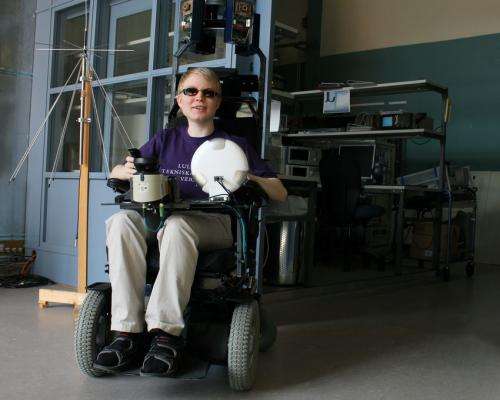'Sighted' wheelchair tested

Research on an electric wheelchair that can sense it's environment and transmit information to a person who is visually impaired, has been tested at Lulea University of Technology, Sweden. Daniel Innala Ahlmark, a prospective graduate student in the research project, and himself visually impaired, dared to make the first public test.
The wheelchair has a joystick for steering and a haptic robot that acts as a virtual white cane. With the help of a laser scanner a simplified 3D map is created of the wheelchair surroundings. The laser scanner uses Time-of-flight technique. The 3D map is transferred to the haptic robot so that a visually impaired wheelchair driver can "feel or see" obstacles such as open doors or oncoming people, and navigate past them.
The “sighted” wheelchair has been developed by Kalevi Hyyppa, a professor at Lulea University of Technology and his research team at the LTU division EISLAB. The other members of the research team are prospective Ph.D. student Daniel Innala Ahlmark, assistant professor Hakan Fredriksson and Ph.D. student Fredrik Broström.
"This may be important aids for the visually impaired who are wheelchair users. Many have already been in touch with me and asked if they can come for a test drive," says Kalevi Hyyppa.
The first test of the “sighted” wheelchair for an audience was carried out in one of the corridors of the Department of Computer Science, Electrical- and Space Engineering at Luleå University of Technology.
There are several classrooms in the corridor, which means that students often pass there. For those who are visually impaired or blind, it is quite a changing environment to move in. Daniel Innala Ahlmark, who is visually impaired, dared to test the wheelchair while explaining how he experienced it - and he did so before the entire local and even national media in Sweden.
"I feel safe when I run it, it is like using a white cane," he said as he avoided various obstacles along the corridor.
There is much left when it comes to improving the 3D sensor and the haptic robot. The laser beam that sweeps in front of the wheelchair hits only objects which are a certain height. It has not the capacity to see things that are higher or lower than that height. Now the research team plan to develop a 3D camera that can do a full 3D measurement. Then the sighted wheelchair can be manufactured and used for real. This might be possible in approximately five years.
Provided by Lulea University of Technology



















